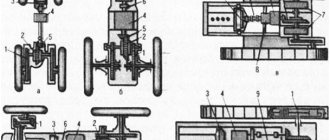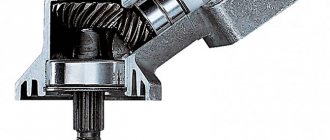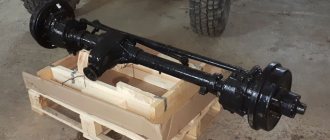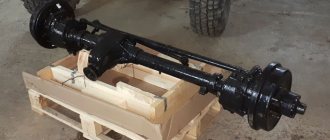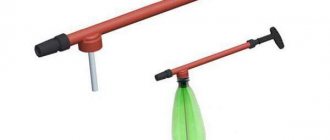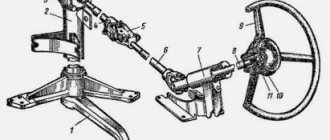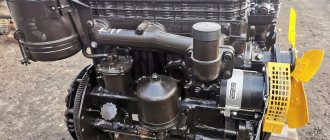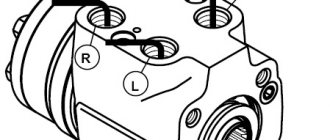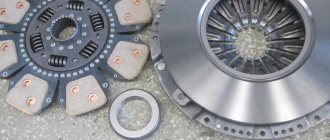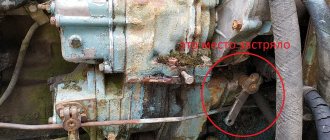In Russia there are people who own small farms used for commercial purposes, and some of them simply buy a large amount of land for a comfortable life. To cultivate more than 1 hectare of untouched land, agricultural machinery will be required. In such cases, the Minsk Tractor Plant offers a miniature model of the MTZ-82 tractor, popular for private use, which helps fulfill all the owner’s needs for caring for a large piece of land.
Wheels on MTZ-82 (front)
Tires for tractor wheels are one of the most important parts in such agricultural machinery, which, in addition to the engine, ensure ideal traction in any mud or muddy soil. Moreover, the rear wheels on the classic MTZ tractor are almost twice as large as the front ones - up to 1.5 meters in diameter and, accordingly, the 12-layer composition makes them invulnerable to punctures by sharp objects. The same cannot be said about the front tires, which have a radius of R20 and have the following features when installed on this agricultural equipment:
Tractor MTZ 82
- What are the sizes of MTZ 82 tires? There are 3 basic configurations and, accordingly, front wheel options for the MTZ-82. In the simplest version, the tire size is 7.5 inches wide, which fits on a 5.5-inch rim in an F edge configuration and a constant R20 radius.
- In the modification intended for plowing fields of 1 hectare and above, the front wheels on the MTZ 82 are made with parameters 8.3-20, and they correspond to stamped welded disks W7-20.
- In those tractor variants that have the appropriate brackets and are designed for the installation of attachments, a tire with powerful mud grips is offered, having dimensions of 11.2-20, and it fits ideally on a wheel with a rim width of W9-20.
Important!
Thus, wheels play a dominant function for the nature of the operation of agricultural machinery, and they must be selected in strict accordance with the tasks assigned to the tractor. Otherwise, the device may not be able to cope with deep dirt, which is why its mechanisms will work mostly idle, which will lead to their rapid wear and the need for premature maintenance.
Front tires on MTZ 82
Sizes and their selection
Typically, the MTZ 82 rear tires are 15.5R38 in size, and the front tires are 11.2-20. For each MTZ model, the manufacturer has established recommended tire sizes. The dimensions are selected according to the inner size of the tire; it must match the outer diameter of the rim. Otherwise, the owner has the right to choose between low- and high-profile tires, based on working conditions and financial capabilities.
Rear tires measuring 15.5-38 are distinguished by a reinforced breaker and radial placement of cord threads in the carcass. Tires whose carcass has a diagonal arrangement of the carcass cord threads form the plane of the tire profile with an angle of 50-54º, and tires with a radial design - their angle does not exceed 5º. The radial arrangement of the cords gives the tire better flexibility. Also, these tires improve the traction and grip qualities of the tractor, compact the soil and slip less, and have a longer tread wear resistance.
Operation and maintenance of MTZ 82 tractor tires
The technical condition of tires affects the traction and grip qualities of the tractor, its fuel consumption, cross-country ability and productivity. Thus, we can safely say that tires largely determine the productive and economical operation of a tractor. In addition, tires are expensive and wear-out components of the tractor, the price of which is about 12% of the cost of the tractor itself. During the entire service life of the tractor, tires are changed 3-4 times, so the cost of operating tires is approximately 20% of the total cost of operating the tractor.
Tire pressure of the MTZ-82 tractor
Operating a tractor is also not the easiest process, since the mechanic must constantly monitor the pressure in the MTZ 82 tires in atmospheres, depending on what specific work the equipment is performing. Thus, the recommended values for the compressor when pumping up cylinders on a tractor are given in the following table in the number of atmospheres:
You might be interested in this About tires for Niva
| Job title | Tires MTZ 82, rear | Tires MTZ 82, front |
| Standard operating mode | 1,4 + 0,1 | 1,4 + 0,1 |
| When plowing a field | 1,0 + 0,1 | 1,4 + 0,1 |
| When using attachments | 1,6 + 0,1 | 2,5 + 0,1 |
From these indicators it is clear that when working in the field, the wheels should be slightly lowered, since in this case the area of the sole that rests on the ground increases slightly, which causes a drop in pressure on the soil, and the tractor becomes more passable.
On a note.
In the case of working with heavy scrapers or buckets, the additional load from them can easily flatten the cylinder, which requires additional pressure to be applied to it.
Rear disc pancakes and tires on MTZ-82
How to repair a tractor if its wheels “oscillate” and “yaw”
Various difficulties also often arise with tractors that require the attention of the operator. For example, the front idler wheels begin to wobble and oscillate over time. This especially happens when driving at high speed. Most often, this indicates a loosening of the thrust bearings of the hydraulic booster spool or their significant wear.
In this case, you need to remove the distributor cap and adjust the spool thrust bearings with a spherical nut. It should be tightened to a torque of no more than 20 N*m (2 kgf*m), and then loosened until the nearest rubber nut coincides with the hole in the threaded part of the worm and cottered.
If the vibrations have decreased, but not completely disappeared, then the steering rod joints should be adjusted. Every 1000 hours of tractor operation it is necessary to adjust the steering linkage joints. This check is carried out by shaking by hand or turning the steering wheel.
In order to adjust the steering linkage, you need to perform the following steps:
1. Disconnect the safety wire 33 from the tip.
2. Use a wrench to tighten plug 32 in such a way as to remove the gap in the hinge joint.
3. Re-lock the plug with safety wire.
Front idler wheel wobble can also be caused by excessive play in the front wheel tapered bearings.
Every 1000 hours of tractor operation, the front wheel hub bearings need to be adjusted. At the same time, if there is axial displacement of the wheel during operation, it should be eliminated immediately, because this causes accelerated tire wear and bearing failure.
Normal axial clearance in bearings is 0.08-0.20 mm.
To determine the axial clearance, you need to lift the wheel and rock it in a vertical plane, which is perpendicular to the plane of rotation. Once you see increased clearance or feel difficulty rotating the wheel, adjust the bearings as follows:
1. Unscrew the bolts and remove the cap 1.
2. Loosen nut 2 by 1/8 turn.
3. Push the wheel with your hand and see how it rotates freely. If the rotation is tight, find and remove the faults - the cuff may stick, the bearing may be broken, etc.
4. When turning the wheel by hand, you need to tighten it until increased resistance to rotation of the wheel appears. Next, unscrew the nut a little, just enough to ensure that the nearest slot in the nut matches the hole in the axle shaft for the cotter pin.
5. Check again for ease of wheel rotation.
6. Now you can tighten the nut back and put the cap back in place, having previously lubricated it.
The wobbling of the front wheels may also be due to a violation of the toe-in of the front wheels.
With factory adjustment on MTZ-80 tractors, the toe-in limits of the front wheels are 2-6 mm, for tractors with FDA - 4-8 mm.
Front idler wheel wobble can also be caused by excessive play in the front wheel tapered bearings.
Every 1000 hours of tractor operation, the front wheel hub bearings need to be adjusted. At the same time, if there is axial displacement of the wheel during operation, it should be eliminated immediately, because this causes accelerated tire wear and bearing failure.
Normal axial clearance in bearings is 0.08-0.20 mm.
To determine the axial clearance, you need to lift the wheel and rock it in a vertical plane, which is perpendicular to the plane of rotation. Once you see increased clearance or feel difficulty rotating the wheel, adjust the bearings as follows:
1. Unscrew the bolts and remove the cap 1.
2. Loosen nut 2 by 1/8 turn.
3. Push the wheel with your hand and see how it rotates freely. If the rotation is tight, find and remove the faults - the cuff may stick, the bearing may be broken, etc.
4. When turning the wheel by hand, you need to tighten it until increased resistance to rotation of the wheel appears. Next, unscrew the nut a little, just enough to ensure that the nearest slot in the nut matches the hole in the axle shaft for the cotter pin.
5. Check again for ease of wheel rotation.
6. Now you can tighten the nut back and put the cap back in place, having previously lubricated it.
The wobbling of the front wheels may also be due to a violation of the toe-in of the front wheels.
With factory adjustment on MTZ-80 tractors, the toe-in limits of the front wheels are 2-6 mm, for tractors with FDA - 4-8 mm.
How to choose the right radius of the front wheels for the MTZ-82
It must be said that the radius of the R20 front wheels installed on this model of the Belarusian tractor is optimal under standard operating mode.
However, the machine can also be used in winter, in conditions of high snow cover, as well as when working in quarries, swamps and other more difficult conditions.
That is why the manufacturer allows drivers to intervene independently and select wheels with other recommended parameters.
- If the equipment makes long journeys along asphalt roads, then the driver can install 7...8 - 18 wheels on it, which will reduce the tread height and the tractor will become more stable on hard surfaces.
- On the contrary, when it comes to using equipment in winter, which requires higher ground clearance, it is permissible to install wheels in dimensions 9...11.5 - 22...24, and the tractor will rise slightly above the ground, and soft mud grips will begin to more confidently pave the way in deep snow.
- When using equipment in the most extreme conditions, when driving through peat bogs or other unsteady surfaces, you will need to create a large torque not only on the rear, but also on the front wheels, which will require the installation of tires 12...14 - 25...26.
Important!
When installing wheels of an off-design radius, the driver should be prepared for more frequent routine maintenance to repair the suspension, bearings in the hub, change the oil and other procedures, since an off-design load on all systems provokes rapid wear of all parts.
Inflating wheels with a compressor on MTZ 82
Malfunctions of the front axle of the MTZ tractor
Extraneous knocks and strong noises in the gearbox indicate a malfunction of the MTZ front axle.
Signs of failure may also include:
· Wheel jamming;
· No blocking;
· Metal particles in the axle crankcase oil;
· Chips.
If the breakdown is identified and repaired in time, replacement of the MTZ front axle will not be required. Therefore, it is necessary to regularly check the technical condition of the tractor.
Noise in the system appears due to wear:
· Tapered flange bearings;
· Teeth of final drive gears;
· Ball bearings;
· Bevel gears.
Increased noise occurs if there is a lack of oil in the crankcase.
Incorrectly adjusted differential bearings can also cause an unusual noise.
If traces of oil appear on the propeller shaft flange or the main gear housing, this means that the elasticity is impaired.
Lubricant leakage also occurs when the cuff is destroyed and the following parts are worn:
· Oil seal;
· Sealing gaskets;
· Inner joint housings.
Traces of oil on the rim or disk flange indicate a broken wheel seal. Lack of lubrication in the system causes the housing to overheat.
A malfunction of the MTZ front axle such as a breakdown of the thrust bearings is detected when the steering wheel is difficult to rotate during maneuvers. The telescopic connections of the suspension are jammed. The elasticity of the springs decreases.
Another common breakdown is that when driving forward, the axle does not automatically engage when towing.
The cause of the malfunction may be wear or deformation of parts, as well as contamination with oxidation products.
During operation, a malfunction of the MTZ front axle often occurs such as broken bolts.
It is quite common for the flange threaded holes to wear out. In such cases, it is necessary to repair the front axle of the tractor yourself. Remove the gearbox cover and check the condition of the parts.
Possible causes of the malfunction:
· Contamination of jammed grooves;
· Deformation of springs;
· Lack of torque transmission from the safety clutch.
If the locking mechanism or differential parts fail, knocking noises when cornering increase.
Unusual noise appears in the front axle housing. Both wheels are not locked.
In case of serious damage, contact a car service center. Specialists know how to remove the front axle. They will quickly eliminate any malfunction and organize the operation of the MTZ.
Repairing the front axle of a tractor is expensive. To reduce costs, perform MTZ maintenance according to the manufacturer's instructions.
A serviceable front axle is a guarantee of a safe and comfortable ride. Eliminate breakdowns at the first sign of abnormalities in the operation of the mechanism.
Replacement of the MTZ front axle is carried out if the unit is unsuitable for repair.
Carry out diagnostics in a timely manner. Keep track of the condition of the tractor, and you will not have to study in the instructions how to remove the front axle.
Mechanical wheel locking on the MTZ-1221 tractor
In some cases, on the most inaccessible sections of roads, a classic rear-wheel drive or four-wheel drive tractor cannot cope with a thick layer of mud and return to its track.
However, this does not mean at all that the equipment will not be able to overcome such a section, since the driver just needs to change the mode - turn on the locking of the center differential and the brakes, which will force the wheels to rotate at the same time and the tractor driver will be able to pull the car out of almost any mud.
This locking system has the following fairly simple design and principle of operation:
- The locking itself is made in the form of two cams, each of which is securely fixed on the drives of standard gears of the device, on the inside of the shafts, which in turn have a special grinding of the end to ensure play of these cams and the couplings installed on them.
- These couplings are connected to a drive made in the form of a separate pedal and lever on one side and, accordingly, to a locking and turning device on the central shaft at the opposite end.
- So, if necessary, the operator simply presses the locking drive pedal, the clutch moves in the space allocated for it, entails a shaft and a locking device, which securely snaps onto the gear, preventing further freedom of rotation of each wheel axle separately.
- This lever with a pedal in the cabin has a spring and automatic reverse action and, if released, it will return to its original position, and the differential lock will be removed and the wheels will begin to rotate normally.
- For longer fixation of the locking lever for the MTZ-1221 tractor, there is a special stopper on the pedal, pressing which causes the clutch to remain in the locked position for a longer time.
You might be interested in this About Bear tires
Tractor tire rupture
Important!
Mechanical wheel locking, although simple to implement and reliable in operation, is difficult to operate and non-functional. Therefore, on modern models of Belarusian technology, a more advanced system is installed - a hydraulic locking drive, which is distinguished by the fact that force and a long arm are no longer required to activate the mechanism, since the traction force increases many times under the action of compressed oil in the piston. However, such a system can cause piston leakage when overloaded and longer and more expensive equipment repairs.
What slows you down
The main (working) brakes, as in any vehicle, are designed to reduce the speed limit and effectively stop the tractor.
The main means of braking is a disc (dry disc brakes), which are equipped with the rear axle shaft gears on the left and right.
A parking brake is necessary for this equipment to firmly hold the tractor in one place, even on slopes or slopes, or under the yoke of any loads and materials, as well as additional attachments.
To hold the machine in one position for a very long time, an auxiliary brake is provided, which is also used when the tractor is on slopes or slopes.
The spare brake acts as an insurer in this device if the main brake system for any reason does not work or fails.
The principle of operation of the brake system of the MTZ tractor is extremely simple, but very effective - the driver just needs to move the lever towards himself, having previously pressed the button located on the handle of the brake lever.
